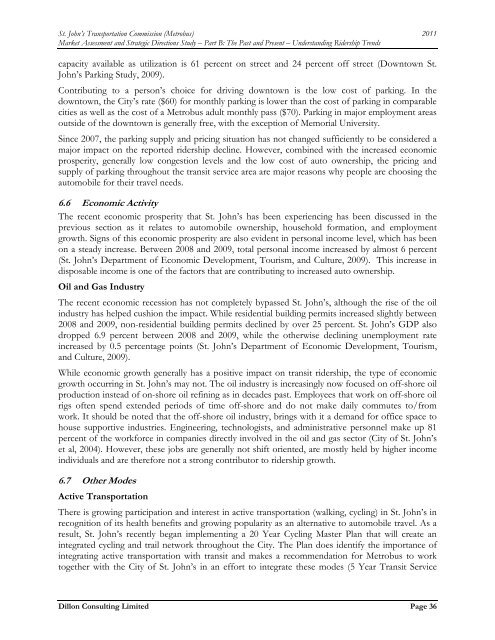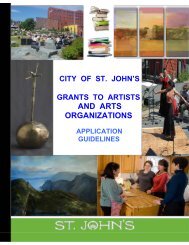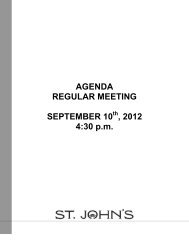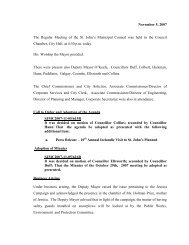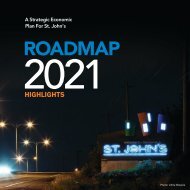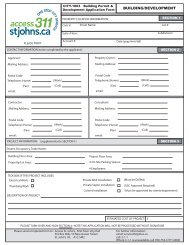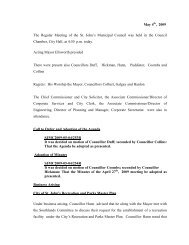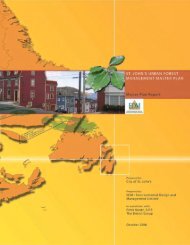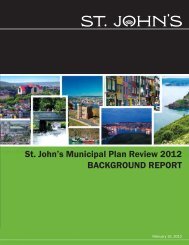Metrobus Transit Study.pdf - City of St. John's
Metrobus Transit Study.pdf - City of St. John's
Metrobus Transit Study.pdf - City of St. John's
Create successful ePaper yourself
Turn your PDF publications into a flip-book with our unique Google optimized e-Paper software.
<strong>St</strong>. John’s Transportation Commission (<strong>Metrobus</strong>) 2011<br />
Market Assessment and <strong>St</strong>rategic Directions <strong><strong>St</strong>udy</strong> – Part B: The Past and Present – Understanding Ridership Trends<br />
capacity available as utilization is 61 percent on street and 24 percent <strong>of</strong>f street (Downtown <strong>St</strong>.<br />
John’s Parking <strong><strong>St</strong>udy</strong>, 2009).<br />
Contributing to a person’s choice for driving downtown is the low cost <strong>of</strong> parking. In the<br />
downtown, the <strong>City</strong>’s rate ($60) for monthly parking is lower than the cost <strong>of</strong> parking in comparable<br />
cities as well as the cost <strong>of</strong> a <strong>Metrobus</strong> adult monthly pass ($70). Parking in major employment areas<br />
outside <strong>of</strong> the downtown is generally free, with the exception <strong>of</strong> Memorial University.<br />
Since 2007, the parking supply and pricing situation has not changed sufficiently to be considered a<br />
major impact on the reported ridership decline. However, combined with the increased economic<br />
prosperity, generally low congestion levels and the low cost <strong>of</strong> auto ownership, the pricing and<br />
supply <strong>of</strong> parking throughout the transit service area are major reasons why people are choosing the<br />
automobile for their travel needs.<br />
6.6 Economic Activity<br />
The recent economic prosperity that <strong>St</strong>. John’s has been experiencing has been discussed in the<br />
previous section as it relates to automobile ownership, household formation, and employment<br />
growth. Signs <strong>of</strong> this economic prosperity are also evident in personal income level, which has been<br />
on a steady increase. Between 2008 and 2009, total personal income increased by almost 6 percent<br />
(<strong>St</strong>. John’s Department <strong>of</strong> Economic Development, Tourism, and Culture, 2009). This increase in<br />
disposable income is one <strong>of</strong> the factors that are contributing to increased auto ownership.<br />
Oil and Gas Industry<br />
The recent economic recession has not completely bypassed <strong>St</strong>. John’s, although the rise <strong>of</strong> the oil<br />
industry has helped cushion the impact. While residential building permits increased slightly between<br />
2008 and 2009, non-residential building permits declined by over 25 percent. <strong>St</strong>. John’s GDP also<br />
dropped 6.9 percent between 2008 and 2009, while the otherwise declining unemployment rate<br />
increased by 0.5 percentage points (<strong>St</strong>. John’s Department <strong>of</strong> Economic Development, Tourism,<br />
and Culture, 2009).<br />
While economic growth generally has a positive impact on transit ridership, the type <strong>of</strong> economic<br />
growth occurring in <strong>St</strong>. John’s may not. The oil industry is increasingly now focused on <strong>of</strong>f-shore oil<br />
production instead <strong>of</strong> on-shore oil refining as in decades past. Employees that work on <strong>of</strong>f-shore oil<br />
rigs <strong>of</strong>ten spend extended periods <strong>of</strong> time <strong>of</strong>f-shore and do not make daily commutes to/from<br />
work. It should be noted that the <strong>of</strong>f-shore oil industry, brings with it a demand for <strong>of</strong>fice space to<br />
house supportive industries. Engineering, technologists, and administrative personnel make up 81<br />
percent <strong>of</strong> the workforce in companies directly involved in the oil and gas sector (<strong>City</strong> <strong>of</strong> <strong>St</strong>. John’s<br />
et al, 2004). However, these jobs are generally not shift oriented, are mostly held by higher income<br />
individuals and are therefore not a strong contributor to ridership growth.<br />
6.7 Other Modes<br />
Active Transportation<br />
There is growing participation and interest in active transportation (walking, cycling) in <strong>St</strong>. John’s in<br />
recognition <strong>of</strong> its health benefits and growing popularity as an alternative to automobile travel. As a<br />
result, <strong>St</strong>. John’s recently began implementing a 20 Year Cycling Master Plan that will create an<br />
integrated cycling and trail network throughout the <strong>City</strong>. The Plan does identify the importance <strong>of</strong><br />
integrating active transportation with transit and makes a recommendation for <strong>Metrobus</strong> to work<br />
together with the <strong>City</strong> <strong>of</strong> <strong>St</strong>. John’s in an effort to integrate these modes (5 Year <strong>Transit</strong> Service<br />
Dillon Consulting Limited Page 36


